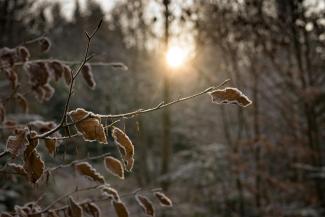The Winter of Our Contentment

The campus I help staff canceled all classes and events this Tuesday due to what looked like a hefty nor’easter winter storm. When I woke up, it was raining, and then, as I wrote this at 4 p.m. that day, not a flake of snow could be seen of the expected 10ish inches we Bostonians had braced ourselves for.
Winter feels like it hijacks our lives a bit, depending on where we’re located. At least up here in New England, we remember sunlight in the evening with nostalgia once Daylight Savings Time ends and the sky is dark by 4 p.m. for several dreary months; we bundle up in layer upon layer when it gets too cold; we save our shoveled-out parking spots with chairs or cones. It’s a different way of life that impacts not only our physical life, but also our emotional life. Seasonal Affective Disorder is real–cloudy day after cloudy day, cold, stuck inside. It gets tough.
We can experience inner winters as well. It feels like nothing is growing within–green has all but disappeared, trees won’t be in bloom for a long time. We feel the weight of silence and latency. It feels like a waste of a season, similar to how it feels externally as we await the warmth of spring in the yearly cycle. But with spiritual seasons, we don’t know when the spring equinox is going to roll around to change the season.
A few years ago, I found myself in a season of winter, spiritually speaking. I have a vivid image in my mind of a drainage waterfall in Beverly, Massachusetts, where I was walking and thinking the day I first recognized my interior state. This cement waterfall was connected to a small reservoir, enabling it to gently drain if it flooded. When I saw it, it was early March 2020 (yikes), and there was barely a trickle coming over the waterway: there was minimal movement, minimal life, just a dreary image of the worst of winter.
of winter, spiritually speaking. I have a vivid image in my mind of a drainage waterfall in Beverly, Massachusetts, where I was walking and thinking the day I first recognized my interior state. This cement waterfall was connected to a small reservoir, enabling it to gently drain if it flooded. When I saw it, it was early March 2020 (yikes), and there was barely a trickle coming over the waterway: there was minimal movement, minimal life, just a dreary image of the worst of winter.
I had a conversation with my spiritual director during that season in which she challenged me: perhaps there is purpose, even beauty, to the silence. Perhaps there is good in the rest that the land experiences in the winter before life blossoms in spring. Over time, I found that to be true, and have encouraged the students I serve to meet Jesus exactly where they are, instead of where they think they should be.
Jesus doesn’t ask us to be in a different season than the one in which we find ourselves. It’s easy to desire a season more than the presence of the Creator. God’s people can meet God in the temple and in the wilderness, in spring and in winter. In the words of singer-songwriter Andy Squyres, “nothing is wasted with you” (“Dead Horse”). It’s particularly in the silent seasons that we can learn to hear God’s voice in intimate ways. In those times that seem barren, we can find God to be our constant companion, whose presence is worth more than his provision. The Narnia-inspired words of Relient K come to mind: “Cause when it’s always winter but never Christmas / Sometimes it feels like you’re not with us / But deep inside our hearts we know / That you are here and we will not lose hope” [“In Like a Lion (Always Winter)”].
I went back to that drainage  waterfall at the reservoir a year later after a snowfall. And before I had even gotten close enough to see it, I could hear it. The snow was melting on the reservoir and was pouring over the waterfall. By means of the snow, the ground is watered, renewed, made ready for spring. There’s always growth happening under the snow, even if you can’t see it yet.
waterfall at the reservoir a year later after a snowfall. And before I had even gotten close enough to see it, I could hear it. The snow was melting on the reservoir and was pouring over the waterfall. By means of the snow, the ground is watered, renewed, made ready for spring. There’s always growth happening under the snow, even if you can’t see it yet.
So, if you’re feeling bogged down by an exterior or interior winter this year, I encourage you: meet Jesus there. Of course, if you need it, talk to a therapist and doctor about medication to help out with the seasonal blues–by all means! That’s helped me get through. But also, there’s value in the silent times, in the seemingly pointless times of waiting and stillness. Instead of wishing for spring or pining for summer, sit in the winter (with a coat on) and listen. You may just grow to enjoy its peacefulness and beauty.







